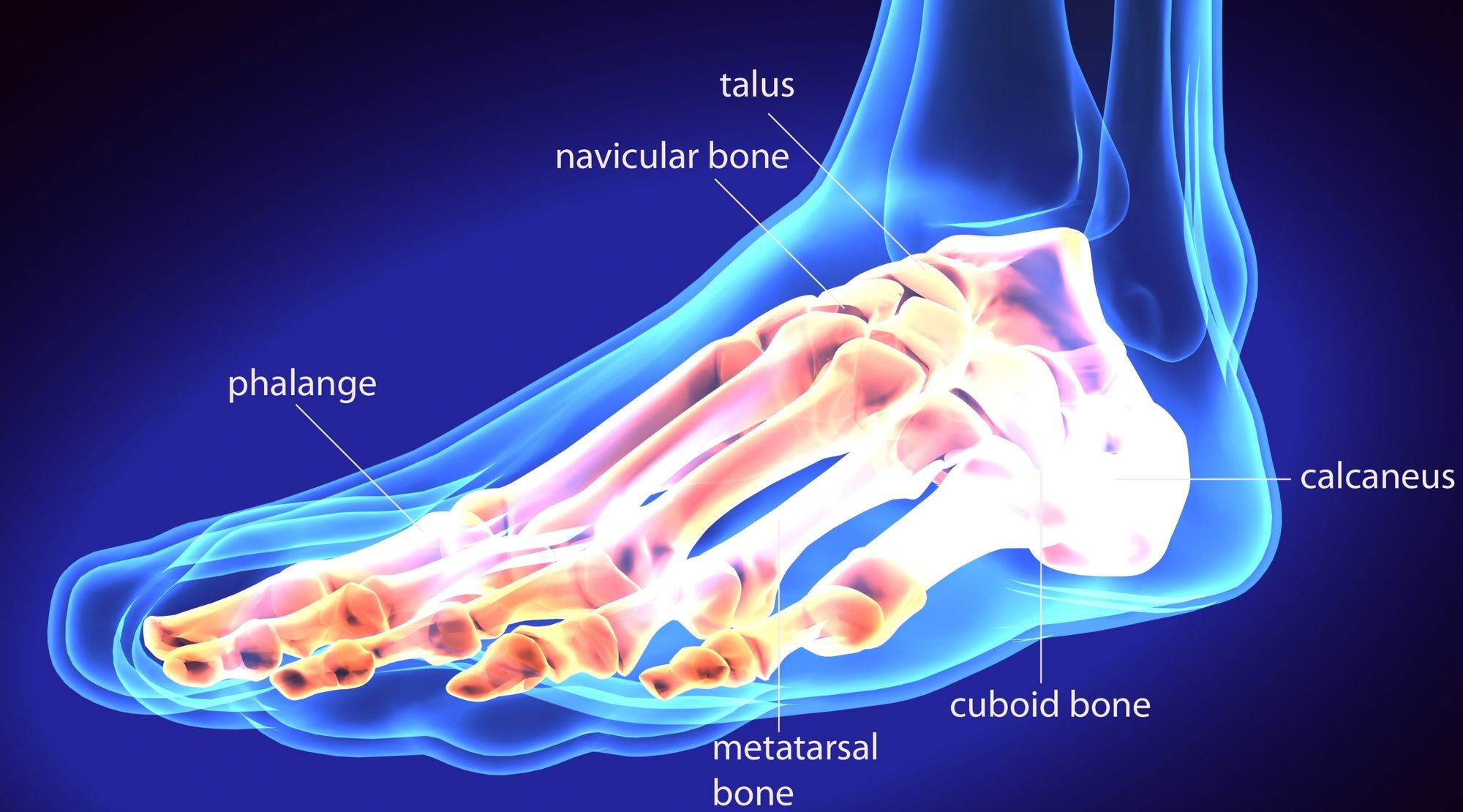All you need to know about foot bones

The foot is a complex structure consisting of 26 bones, 33 joints, 107 ligaments, and 19 muscles. Since the bones and joints in the feet are subject to wear and tear, conditions that affect the foot can directly influence its health. This article provides an overview of the anatomy of the foot bones, as well as some of the most prevalent conditions that affect them.
Anatomy of Foot Bones
The human foot comprises 26 bones that fall into three categories: the tarsal bones, metatarsal bones, and phalanges.

The tarsal bones are a group of seven bones that make up the rear section of the foot. The talus or ankle bone is the bone at the top of the foot that connects with the tibia and fibula bones of the lower leg. The calcaneus or heel bone, which supports body weight, is the largest of the tarsal bones. The tarsals include the medial, intermediate, and lateral cuneiforms, the cuboid, and the navicular, and they form the arch of the midfoot.
The metatarsal bones are a group of five tubular bones in the middle of the foot that connect to the tarsal bones and phalanges. The metatarsals sit in a row, numbered one to five by doctors, with the first bone closest to the arch of the foot, and the fifth bone located at the outer edge of the foot. The phalanges are the bones in the toes, with the second to fifth toes each containing three phalanges. Doctors call them the proximal, middle, and distal phalanges from the back of the foot to the front, while the big toe or hallux has only two phalanges, which are proximal and distal. The metatarsal phalangeal joints are the joints between the metatarsals and the proximal phalanx of each toe, forming the ball of the foot. The first metatarsal phalangeal joint, located in line with the big toe, is a common area for foot pain and other problems.
Conditions Affecting Foot Bones Common conditions that affect foot bones include:
Big Toe Arthritis
Big toe arthritis, also known as hallux limitus or hallux rigidus, is the most frequent type of arthritis that affects the feet. It occurs when the cartilage in the joint of the big toe starts to wear away, primarily as a result of many years of repetitive upward movement of the joint. Prolonged running and walking can increase the risk of developing arthritis in this area. Symptoms of big toe arthritis include pain, stiffness, and swelling in the big toe, a bone spur, and metatarsalgia, or pain and inflammation in the ball of the foot.
Bunions

Bunions are a typical complication that affects foot bones. They develop when the bone at the base of the big toe, the first metatarsal, starts to separate from the bone at the base of the second toe, the second metatarsal. As the first metatarsal drifts outwards, it causes the big toe to drift toward the other toes, causing the bunion to become more prominent. A person with a bunion may experience pain and discomfort at the site of the bunion or underneath the ball of the foot. These symptoms may worsen when walking or standing.
Gout
Gout is a type of inflammatory arthritis that typically affects the joint at the base of the big toe. It usually occurs due to a high concentration of uric acid in the blood. In people with gout, excess uric acid begins to accumulate and form crystals in the joints
When to see a doctor

People should seek medical attention if they experience foot pain or discomfort that does not go away after a few days of rest, icing, and elevating the affected foot.
A doctor will be able to diagnose any underlying conditions and develop a treatment plan. In some cases, they may refer the person to a podiatrist, who is a specialist in diagnosing and treating foot and ankle problems.
If the person has a known condition affecting the feet, such as arthritis, they should continue to monitor their symptoms and see a doctor regularly to ensure their condition is well managed.
Summary
The foot is an important part of the body, consisting of 26 bones, 33 joints, 107 ligaments, and 19 muscles. The bones in the feet are divided into three groups: the tarsal bones, metatarsal bones, and phalanges.
Common conditions affecting the foot bones include big toe arthritis, bunions, gout, hammer toes, and heel spurs. If a person experiences foot pain or discomfort that does not go away after a few days, they should see a doctor. Regular check-ups are also important for people with a known condition affecting the feet.
SOURCES
- Anatomy of the foot (n.d.).
https://www.arthritis.org/about-arthritis/where-it-hurts/foot-heel-and-toe-pain/foot-anatomy.php - Bunions. (2016).
https://orthoinfo.aaos.org/en/diseases--conditions/bunions/ - Claw toe. (2012)
https://orthoinfo.aaos.org/en/diseases--conditions/claw-toe/ - Foot: Vertebrate anatomy (n.d.).
https://www.britannica.com/science/foot - Metatarsal: Bone (n.d.).
https://www.britannica.com/science/metatarsal - Phalanx (n.d.).
https://www.britannica.com/science/phalanx-bone - Plantar fasciitis and bone spurs. (2010).
https://orthoinfo.aaos.org/en/diseases--conditions/plantar-fasciitis-and-bone-spurs - Sesamoiditis (2012).
https://orthoinfo.aaos.org/en/diseases--conditions/sesamoiditis - Stiff big toe (hallux rigidus). (2017 ).
https://orthoinfo.aaos.org/en/diseases--conditions/stiff-big-toe-hallux-rigidus - Tarsal: Bone. (n.d.).
https://www.britannica.com/science/tarsal - When to see a foot and ankle surgeon. (n.d.).
https://www.foothealthfacts.org/articles/when-to-visit-a-foot-ankle-surgeon